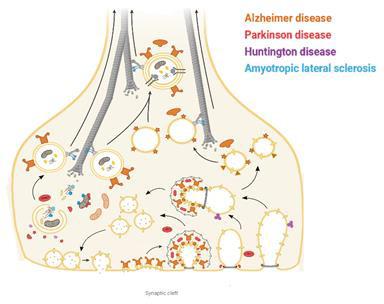当前位置:
X-MOL 学术
›
J. Neurochem.
›
论文详情
Our official English website, www.x-mol.net, welcomes your
feedback! (Note: you will need to create a separate account there.)
Mechanisms of neuronal survival safeguarded by endocytosis and autophagy
Journal of Neurochemistry ( IF 4.2 ) Pub Date : 2020-09-22 , DOI: 10.1111/jnc.15194 Melina Overhoff 1 , Elodie De Bruyckere 1 , Natalia L Kononenko 1
Journal of Neurochemistry ( IF 4.2 ) Pub Date : 2020-09-22 , DOI: 10.1111/jnc.15194 Melina Overhoff 1 , Elodie De Bruyckere 1 , Natalia L Kononenko 1
Affiliation

|
Multiple aspects of neuronal physiology crucially depend on two cellular pathways, autophagy and endocytosis. During endocytosis, extracellular components either unbound or recognized by membrane‐localized receptors (termed “cargo”) become internalized into plasma membrane‐derived vesicles. These can serve to either recycle the material back to the plasma membrane or send it for degradation to lysosomes. Autophagy also uses lysosomes as a terminal degradation point, although instead of degrading the plasma membrane‐derived cargo, autophagy eliminates detrimental cytosolic material and intracellular organelles, which are transported to lysosomes by means of double‐membrane vesicles, referred to as autophagosomes. Neurons, like all non‐neuronal cells, capitalize on autophagy and endocytosis to communicate with the environment and maintain protein and organelle homeostasis. Additionally, the highly polarized, post‐mitotic nature of neurons made them adopt these two pathways for cell‐specific functions. These include the maintenance of the synaptic vesicle pool in the pre‐synaptic terminal and the long‐distance transport of signaling molecules. Originally discovered independently from each other, it is now clear that autophagy and endocytosis are closely interconnected and share several common participating molecules. Considering the crucial role of autophagy and endocytosis in cell type‐specific functions in neurons, it is not surprising that defects in both pathways have been linked to the pathology of numerous neurodegenerative diseases. In this review, we highlight the recent knowledge of the role of endocytosis and autophagy in neurons with a special focus on synaptic physiology and discuss how impairments in genes coding for autophagy and endocytosis proteins can cause neurodegeneration.
中文翻译:

内吞和自噬保护神经元存活的机制
神经元生理学的多个方面至关重要地取决于两个细胞途径,自噬和胞吞作用。在胞吞过程中,未结合或未被膜定位受体(称为“货物”)识别的细胞外成分会被内化到质膜衍生的囊泡中。这些可以用来将材料再循环回到质膜,或将其发送降解为溶酶体。自噬也使用溶酶体作为终末降解点,尽管自噬并不会降解有害的质膜物质,而是消除了有害的胞质物质和细胞内细胞器,这些物质通过双膜囊泡(称为自噬体)转运至溶酶体。像所有非神经元细胞一样,神经元 利用自噬和内吞作用与环境进行交流,并维持蛋白质和细胞器的体内平衡。此外,神经元的高度极化,有丝分裂后性质使它们采用这两种途径实现细胞特异性功能。这些包括维持突触前末端的突触囊泡池和信号分子的长距离运输。最初彼此独立发现,现在很清楚,自噬和内吞作用紧密相连,并共享几个共同的参与分子。考虑到自噬和内吞作用在神经元细胞类型特定功能中的关键作用,这两种途径的缺陷都与许多神经退行性疾病的病理学联系在一起就不足为奇了。在这篇评论中,
更新日期:2020-09-22
中文翻译:

内吞和自噬保护神经元存活的机制
神经元生理学的多个方面至关重要地取决于两个细胞途径,自噬和胞吞作用。在胞吞过程中,未结合或未被膜定位受体(称为“货物”)识别的细胞外成分会被内化到质膜衍生的囊泡中。这些可以用来将材料再循环回到质膜,或将其发送降解为溶酶体。自噬也使用溶酶体作为终末降解点,尽管自噬并不会降解有害的质膜物质,而是消除了有害的胞质物质和细胞内细胞器,这些物质通过双膜囊泡(称为自噬体)转运至溶酶体。像所有非神经元细胞一样,神经元 利用自噬和内吞作用与环境进行交流,并维持蛋白质和细胞器的体内平衡。此外,神经元的高度极化,有丝分裂后性质使它们采用这两种途径实现细胞特异性功能。这些包括维持突触前末端的突触囊泡池和信号分子的长距离运输。最初彼此独立发现,现在很清楚,自噬和内吞作用紧密相连,并共享几个共同的参与分子。考虑到自噬和内吞作用在神经元细胞类型特定功能中的关键作用,这两种途径的缺陷都与许多神经退行性疾病的病理学联系在一起就不足为奇了。在这篇评论中,











































 京公网安备 11010802027423号
京公网安备 11010802027423号